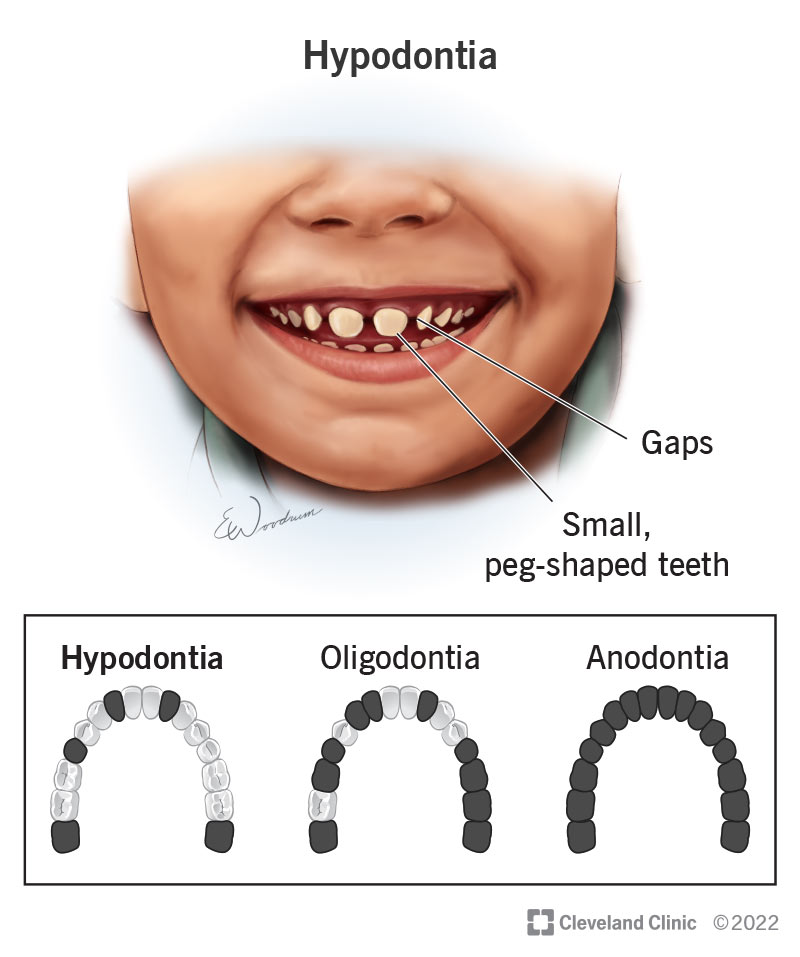People with hypodontia are born with missing teeth. In other words, their teeth never develop. Hypodontia specifically refers to one to six missing teeth. The most common cause of hypodontia is heredity, which means biological parents pass the condition to their children. Treatments include bridges, dentures, dental implants and orthodontics.
Advertisement
Cleveland Clinic is a non-profit academic medical center. Advertising on our site helps support our mission. We do not endorse non-Cleveland Clinic products or services. Policy

“Hypodontia” is the medical term for being born without some of your teeth. It’s a form of dental agenesis — a term healthcare providers use to describe congenitally missing teeth. (“Congenitally” means you’re born with the condition.) Specifically, a person with hypodontia is missing one to six teeth (not counting wisdom teeth). Between 2% and 8% of the general population has hypodontia. Anyone can be born with it.
Advertisement
Cleveland Clinic is a non-profit academic medical center. Advertising on our site helps support our mission. We do not endorse non-Cleveland Clinic products or services. Policy
Hypodontia can occur in any area of your mouth. But the teeth most commonly missing in people with hypodontia include your:
Missing teeth can interfere with your ability to eat and speak. Hypodontia may also cause gum damage and inadequate jawbone growth. This lack of bone growth can lead to an underdevelopment of your jaw, making it appear smaller than it should be.
Hypodontia is a birth defect. Children can inherit hypodontia from their biological parents.
In some cases, infants and young children may develop hypodontia if they had certain illnesses, infections or treatments (like chemotherapy or radiation) during their tooth development phase.
The most common symptom of hypodontia is being born missing one to six teeth. The missing teeth can occur anywhere in your mouth — except your wisdom teeth. Hypodontia can affect primary (baby) teeth or permanent (adult) teeth. People with hypodontia may also have existing teeth that are peg-shaped or smaller than average. They may also have gaps and spaces between their existing teeth.
Advertisement
Hypodontia can also be a symptom of other genetic disorders. Some people with hypodontia may also develop symptoms of ectodermal dysplasias. People with ectodermal dysplasia may have:
People with hypodontia usually have an abnormality affecting the dental lamina — a band of tissue under your gums where your teeth form. In most cases, family history is the cause. But other factors can result in hypodontia, too.
Hypodontia can occur alongside other conditions or treatments, such as:
There are several genes responsible for hypodontia, including:
Depending on the specific gene, inheritance can follow different modes. Like most genetic disorders, healthcare providers determine them by looking at the status of the two copies of a gene: one from each biological parent.
People with hypodontia may inherit the condition in one of four ways:
Two copies of an abnormal gene — one from each biological parent — are necessary for hypodontia to develop.
Only one copy of an abnormal gene — from either biological parent — is necessary for hypodontia to develop.
There’s one dominant abnormal gene on the X chromosome. This means that a male who has X-linked hypodontia will pass the abnormal gene to all of his daughters.
There are one to two recessive abnormal genes on the X chromosomes. This means that a female who has X-linked hypodontia has a:
If your healthcare provider suspects hypodontia, dental X-rays can confirm the diagnosis. During an exam, a dentist will look for other signs of hypodontia, including small teeth, peg-shaped teeth and spacing between teeth.
Hypodontia treatments may include:
Children with hypodontia typically wear partial dentures until they’re old enough for other treatments.
Hypodontia isn’t dangerous or life-threatening. But left untreated, it can severely limit your quality of life. Fortunately, dentists, orthodontists and other dental providers can treat and manage the condition with personalized treatment.
Advertisement
Because hypodontia is usually hereditary, there’s nothing you can do to keep it from happening. But remember, even if you have hypodontia, it doesn’t guarantee that you’ll pass it on to your children.
If your child’s primary teeth don’t erupt (emerge from their gums) by age 4 — or permanent teeth by age 14 — then a dentist should evaluate the issue. If you’re concerned about your child’s missing teeth, ask your dentist about it during a routine office visit.
If you or your child has hypodontia, here are some questions to consider asking your healthcare provider:
Hypodontia is a congenital condition characterized by one to six missing teeth. The condition can make eating and speaking a challenge. But the good news is that it’s treatable. If you or your child has hypodontia, talk to your dentist about options that can restore your smile, confidence and quality of life.
Advertisement
Dentistry plays an important role in oral health. Cleveland Clinic’s experts can design a personalized plan that will keep you smiling for the long haul.

Last reviewed on 09/16/2022.
Learn more about the Health Library and our editorial process.